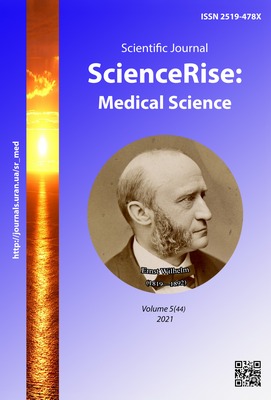Histological study of the effect of bacterial lysates on the state of periodontal tissue in experimental periodontitis in rats
DOI:
https://doi.org/10.15587/2519-4798.2021.241983Keywords:
periodontitis, histological and morphometric profile, bacterial lysateAbstract
The aim of the research: to experimentally study at the histological and morphological level the degree of the corrective effect of bacterial lysate of the disturbed non-specific defense of the body on the model of periodontitis based on the Central Research Laboratory of the National University of Pharmacy.
Materials and methods: prospective study has been conducted on experimental periodontitis in 42 rats for 90 days. The animals were treated with «Respibron» and the reference drug «Imudon». Histological and morphometric studies were carried out according to standard methods. Micropreparations were viewed under a Granum DCM 310 digital video camera. All interventions and euthanasia of animals were carried out in compliance with the European principles.
Results: by the end of 90 days of experimental periodontitis at the local level in the homogenate of animal gum tissue compensatory mechanisms are depleted and differed from the norm by 397 times. The dynamics of the studied morphometric and histological parameters of "Respibron" was similar to the "Imudon", but the magnitude of destruction was less pronounced and differed at the end of the experiment by 17.2 times in comparison with the intact control, and in the control group the results improved by 23.1 times.
Conclusion: the obtained data from the study indicate a high decompensation of experimental periodontitis. It is characterized by the formation of periodontal pockets and inflammatory bone loss. The magnitude of destruction differed from the norm by 397 times. Applying of bacterial lysates led to the compensation of bacterial dysbiosis, restoration of the tissues of paradont. The therapeutic effect of "Respibron" can be assessed as more powerful in comparison with "Imudon" in terms of the studied morphometric and histological parameters: the magnitude of improvement "Respibron" was 3.72 times higher than the indicators of "Imudon". We should continue the study of experimental periodontitis as mechanisms of development, protection, and restoration of tissues under conditions of pharmacological correction by bacterial lysate "Respibron"
References
- Borisenko, A. V. (2013). Zabolevaniya parodonta. Kyiv: VSI «Meditsina», 456.
- Ushakov, R. V., Gerasimova, T. P. (2017). Mekhanizmy tkanevoi destruktsii pri parodontite. Stomatologiya, 4, 63–66.
- Borzikova, N. S. (2015). Markers of inflammation in the periodontal diseases. Medical Council, 2, 78–79.
- Ponomareva, N. A., Gus’kova, A. A., Mitina, E. N., Grishin, M. I. (2017). Modern methods of treatment of inflammatory diseases of the parodont. Health and Education Millennium, 19 (10), 123–125. doi: http://doi.org/10.26787/nydha-2226-7425-2017-19-10-123-125
- Sidelnikova, L. F., Dimitrova, A. G., Kolenko, YU. G. (2018). Otsenka effektivnosti primeneniya immunomodulyatora v kompleksnom lechenii generalizovanogo parodontita. Stomatologiya: ot nauki do praktiki, 1, 86.
- Darenskaya, M. A., Grebenkina, L. A., Mokrenko, E. V., Suslikova, M. I., Gubina, M. I., Goncharov, I. S. et. al. (2019). Korrektsiya metabolicheskikh narushenii pri vospalitelnykh zabolevaniyakh parodonta u krys s pomoschyu immunomodulyatora. Sovremennye problemy nauki i obrazovaniya, 2. Available at: http://science-education.ru/ru/article/view?id=28742 Last accessed: 06.12.2020
- Corona, P. S., Lung, M., Rodriguez-Pardo, D., Pigrau, C., Soldado, F., Amat, C., Carrera, L. (2018). Acute periprosthetic joint infection due to Fusobacterium nucleatum in a non-immunocompromised patient. Failure using a Debridement, Antibiotics + Implant retention approach. Anaerobe, 49, 116–120. doi: http://doi.org/10.1016/j.anaerobe.2017.12.010
- Butenko, H. M., Tereshina, O. P., Maksymov, Yu. M., Arkadiev, V. H et. al.; Stefanova, O. V. (Ed.) (2001). Vyvchennia imunotoksychnoi dii likarskykh zasobiv. Kyiv: Avitsena, 102–114.
- Kushkun, A. A. (2007). Rukovodstvo po laboratornym metodam diagnostiki. Moscow: «GEOTAR-Media», 800.
- Colgan, S. P. (2015). Neutrophils and inflammatory resolution in the mucosa. Seminars in Immunology, 27 (3), 177–183. doi: http://doi.org/10.1016/j.smim.2015.03.007
- Dimitrova, A. G., Kolenko, YU. G. (2017). Otsenka effektivnosti razlichnykh immunomodulyatorov v kompleksnom lechenii generalizovannogo parodontita u lits molodogo vozrasta (18–25 let). Sovremennaya stomatologiya, 2, 38–39.
- Ortiz-García, Y. M., García-Iglesias, T., Morales-Velazquez, G., Lazalde-Ramos, B. P., Zúñiga-González, G. M., Ortiz-García, R. G., Zamora-Perez, A. L. (2019). Macrophage Migration Inhibitory Factor Levels in Gingival Crevicular Fluid, Saliva, and Serum of Chronic Periodontitis Patients. BioMed Research International, 2019, 1–7. doi: http://doi.org/10.1155/2019/7850392
- Pedigo, R. A., Amsterdam, J. T. (2018). Oral medicine. Rosen’s emergency medicine: concepts and clinical practice. Сhap. 60. 9th ed. Philadelphia: Elsevier. doi: http://doi.org/10.1016/b978-0-323-05472-0.00068-2
- Dommisch, H., Kebschull, M.; Newman, M. G., Takei, H. H., Klokkevold, P. R., Carranza, F. A. (Eds.) (2015). Chronic periodontitis. Carranza’s clinical periodontology. Сhap. 23. 12th ed. St Louis: Elsevier Saunders, 313–320.
- Lutskaya, I. K. (2017). Bolezni parodonta. Moscow: Meditsinskaya literatura, 256.
- Bose, A., Shetty, S., Ajila, V. (2016). Molecular biology of host microbial interaction in periodontal disease. LAP LAMBERT Academic Publishing, 160.
- Campbell, E. L., Kao, D. J., Colgan, S. P. (2016). Neutrophils and the inflammatory tissue microenvironment in the mucosa. Immunological Reviews, 273 (1), 112–120. doi: http://doi.org/10.1111/imr.12456
Downloads
Published
How to Cite
Issue
Section
License
Copyright (c) 2021 Mariia Ievtushenko, Elena Kosheva, Svitlana Kryzhna

This work is licensed under a Creative Commons Attribution 4.0 International License.
Our journal abides by the Creative Commons CC BY copyright rights and permissions for open access journals.
Authors, who are published in this journal, agree to the following conditions:
1. The authors reserve the right to authorship of the work and pass the first publication right of this work to the journal under the terms of a Creative Commons CC BY, which allows others to freely distribute the published research with the obligatory reference to the authors of the original work and the first publication of the work in this journal.
2. The authors have the right to conclude separate supplement agreements that relate to non-exclusive work distribution in the form in which it has been published by the journal (for example, to upload the work to the online storage of the journal or publish it as part of a monograph), provided that the reference to the first publication of the work in this journal is included.









